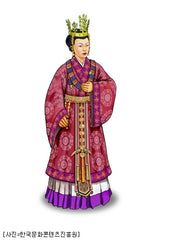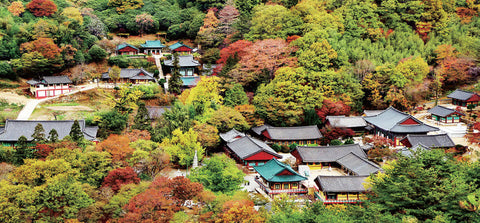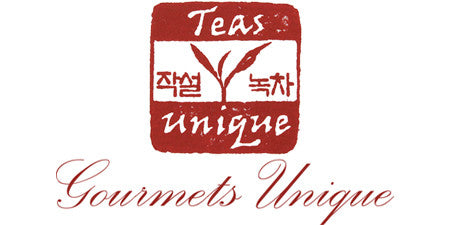History of Korean Tea
Tea Comes to the Land of Morning Calm

|
 |
First introduced from Tang Dynasty China during the reign of Queen Seondeok (632 – 647), Nokcha (green tea), has a long and interesting history in Korea. Imported from China and used as a medicinal herb, green tea powder also came to be used for drinks on ceremonial occasions and for spirit offerings. During the Unified Silla Kingdom reign of King Heungdeok (826 – 836), Kim Taeryom was sent as a royal envoy to Tang China. He returned with camellia sinensus seeds which were planted near the Ssanggyesa monastery on Mt. Jiri in Hadong County, Gyeongnam Province. Thus began Korea’s cultivation and production of tea, which enjoyed steady growth and popularity among the aristocracy, Buddhist monks and the common people.
During the Koryo Dynasty (918 – 1392), tea culture flourished in Korea and was widely promoted by the aristocracy and the Buddhist monasteries. The demand for tea ceremony utensils, pots and cups drove innovation and creativity in the world-famous Korean celadon pottery industry and the numerous artistic achievements of that era.
After the death of King Sejong (1450) of the Joseon Dynasty, all Buddhist ceremonies were replaced by Confucian rites and the monasteries were heavily persecuted. Because of the strong connection between tea and Buddhism, tea was replaced by wine as a formal drink. Despite the imposition of high taxes on tea production, the monasteries managed to maintain some semblance of tea culture, although many tea fields were destroyed during this period.
By the end of the 16th century, there were few vestiges of Korean tea cultivation and production, and what remained was mostly destroyed during the Seven Year’s War with Japan (1592 – 1598) which ravaged the southern provinces where tea production was centered. Korean tea culture struggled to survive in the ensuing years. Enjoying a brief flourishing during the second half of the 19th century, Korea’s tea industry was dealt repeated and near fatal blows as a result of hardships, privations and destruction of the Japanese Occupation (1910 – 1945), World War II and the Korean War (1950 – 1953).
Korean Tea, Tisane and Coffee Today
Today, every beverage known to man is available for enjoyment in Korea. Among hot beverages, coffee is king. In Seoul, there is a coffee shop on every block and in busier areas, there are several coffee shops on every block. Camellia sinensus tea is also commonly available in cafes, and there are a few tea shops that offer a wide variety of green and oxidized teas and traditional Korean tisane beverages. What is tisane? Only beverages made from camellia sinensus can properly be called "tea", so any beverage made by infusing a different plant is technically a tisane, not a tea.
In most traditional Korean restaurants, you will be served boricha (roasted barley tisane) with your meal, served hot in winter and cold in summer. This is the most common tisane in Korea, but there are many others, including tisanes made from ginseng, ginger, angelica, Solomon's Seal, persimmon, jujube, quince, roasted corn, pine needles, etc. All of these beverages, including real tea, are traditional elements of Korean cuisine and herbal medicine, and still have a prominent place in Korean life today.
Learn More
To learn more about Korean green tea, be sure to visit our pages About Korean Tea, the Tea Growing Regions of Korea and Korean Tea Grades.
